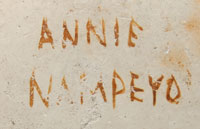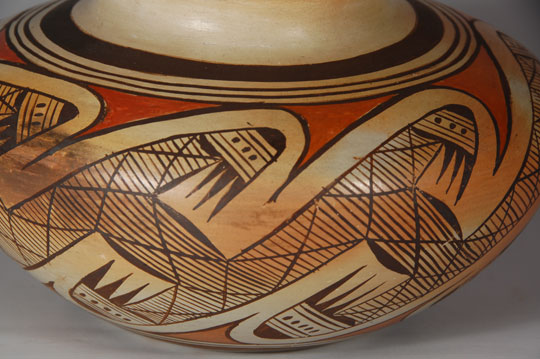Hopi Polychrome Seed Jar signed Annie Nampeyo [SOLD]
+ Add to my watchlist Forward to Friend
- Category: Modern
- Origin: Hopi Pueblo, Hopituh Shi-nu-mu
- Medium: clay, pigments
- Size: 4-1/2” tall x 7-5/8” diameter
- Item # C3206A SOLD

During the late nineteenth century, museums sent expeditions to the Southwest Indian Reservations to make massive collections of pottery and other household items from contemporary homes and archaeological excavations. The result was with mixed blessings. The potters realized that the museums preferred the prehistoric pottery to the contemporary ones, so it did not take them long to realize they could recreate the old styles.
Nampeyo was one of the best. There was no intent to deceive the buyers. The potters, including Nampeyo, were making what was in demand and were not concealing that they were new. Nampeyo placed her pottery on a rug out in front of her house and sold it to whoever came by. Her daughter, Annie, was very proficient at pottery making at that time and Nampeyo placed Annie's pottery with her own. Buyers assumed they were buying pottery by Nampeyo and many such pieces made by Annie were placed in museums as being made by Nampeyo.
There is no question as to the maker of this polychrome seed jar as it is clearly signed Annie Nampeyo. It might be assumed that Annie started signing her pottery during the time that her mother was losing her eyesight in the 1930s. It does not appear that she signed many of her pieces as there are very few that bare her signature.
Condition: This jar is in excellent condition. There is a beautiful orange blush on one side and a fire cloud on the opposite, proof positive of traditional outdoor firing.
Provenance: ex.coll. Phoenix AZ Hopi pottery collector.
Recommended Reading: Nampeyo and her Pottery by Barbara Kramer

- Category: Modern
- Origin: Hopi Pueblo, Hopituh Shi-nu-mu
- Medium: clay, pigments
- Size: 4-1/2” tall x 7-5/8” diameter
- Item # C3206A SOLD



